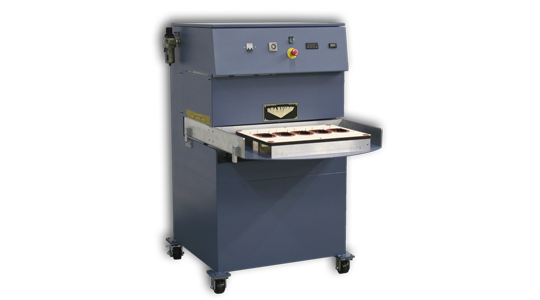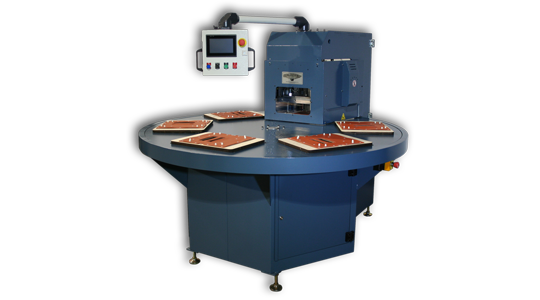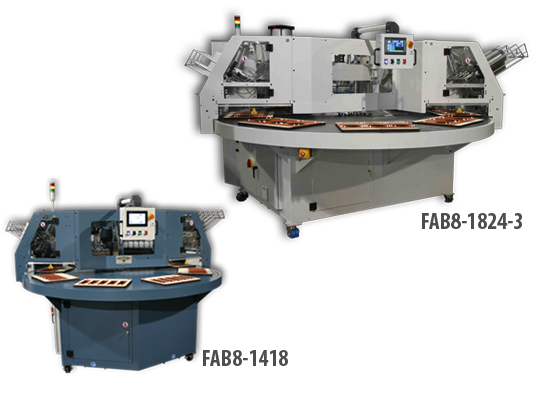A Guide to Rotary Blister Sealers
How This Machine Can Increase Your Production
Topics We Will Cover:
- What a rotary blister does
- Manual vs semi-automatic vs automatic
- What types of industries and products utilize these machines
- How a rotary sealer compares to manual and inline sealers
- Automatic vs Semi-Automatic
What a Rotary Blister Does:
Rotary blister sealers are a great way for those who are looking to seal plastic around a card, usually cardboard. These are placed at the end of the product line and are used for packaging.
Some standard examples of these are furniture assembly tools, batteries, toothbrushes, etc. In particular, those items that you want to keep from being tampered with, stolen, or displayed on hangers in stores.
There are multiple types that can fit your output and production needs, and typically fall under the categories of manual, semi-automatic, and automatic machines.
Manual Vs Semi-Automatic Vs Automatic:
Manual Blister Sealers;
 A manual blister sealer is all dependent on the operator of the machine. The machine is hand-loaded where the plastic seal is placed in the tooling platen to ensure that the placement is correct. Then the cardboard backing is placed on top of the plastic blister and an operator then pulls a lever or lowers the heat onto the cardboard and plastic to form the seal around the product.
A manual blister sealer is all dependent on the operator of the machine. The machine is hand-loaded where the plastic seal is placed in the tooling platen to ensure that the placement is correct. Then the cardboard backing is placed on top of the plastic blister and an operator then pulls a lever or lowers the heat onto the cardboard and plastic to form the seal around the product.
This limits the overall output of the machine but is helpful if your production is low and is less costly. It also allows you to package your product individually and provide visibility to the product.
These machines typically produce 1-6 cases per minute.
(Image Source: https://www.starview.net/starview-packaging-blister-sealers.html)
Semi-Automatic;
 Blister Sealers
The semi-automatic blister sealer is great for customers who are looking for medium-volume production. These machines still require an operator to place and seal the materials but can handle more products and create a higher output rate. For these machines there are multiple operators who will place the cardboard, then the product, then the plastic (all at separate stations) into the custom platen. The product rotates on the sealing table until it reaches the sealer where everything is heated and formed accordingly. The operator then removes the completed package and is started all over again.
Blister Sealers
The semi-automatic blister sealer is great for customers who are looking for medium-volume production. These machines still require an operator to place and seal the materials but can handle more products and create a higher output rate. For these machines there are multiple operators who will place the cardboard, then the product, then the plastic (all at separate stations) into the custom platen. The product rotates on the sealing table until it reaches the sealer where everything is heated and formed accordingly. The operator then removes the completed package and is started all over again.
These machines are great for those who are looking to create higher volume but don’t need to fully automate at this time.
These machines can typically produce 1-15 cases per minute.
(Image Source: https://www.starview.net/starview-packaging-blister-sealers.html)
Automatic Blister Sealers:
 Automatic machines do exactly what you would think - automate the process of blister sealing. This machine does not require an operator and places and seals the materials on its own.
Automatic machines do exactly what you would think - automate the process of blister sealing. This machine does not require an operator and places and seals the materials on its own.
They place the packaging and the product in the platen specific to the product. The machine then uses its rotary table to rotate the product while also de-nesting the plastic. This is a key separator between the automatic and semi-automatic. Most of the time the machines can do 20 cycles a minute, drastically increasing the packaging process and your output.
These machines often have multiple stations as well to increase productivity. The machines pull the plastic, product, and backing from automatic feeders, and the finished product is off-loaded onto the next stage of the packaging process.
These machines can typically produce 1-18 cases per minute.
(Image Source: https://www.starview.net/starview-packaging-blister-sealers.html)
Types of Products:
Because the rotary blister sealer is so versatile, it can be used in a variety of products and a variety of industries. Some of the most common uses are:
- Toys
- Medical devices
- Cosmetic Products
- Products that contain loose parts such as furniture hardware and automotive parts
- Products that require theft protection such as memory cards and gift cards
Ultimately, any industry with loose parts or those who need tamper-proof products, need their products on display or need to have a secure seal.
Upstream vs Downstream
For anyone looking to scale their business up, if you are looking to semi-automate or automate your rotary blister sealer, we recommend looking at the following machines:
For downstream look into what your packaging equipment can currently handle and if moving to a newer or more productive machine would mean having to either invest in or enhance your production including:
Manufacturers:
SIGMA Equipment works with hundreds of manufacturers and equipment dealers to help make sure you find the equipment to fit your needs. However, for rotary blister sealers, here are some of our recommended manufacturers:
- Starview
Trends:
As more and more enhancements have been made in the packaging industry, most companies are opting for easier-to-open packaging. Because customers have been cut or injured on the packaging these machines are not being utilized as often as they have been in the past.
Considerations:
One of the biggest takeaways for consideration is what tooling do you need for your product. Or, when purchasing a used rotary blister sealer, knowing what the tooling was so you’ll know what you need to reconfigure.
When working with SIGMA Equipment, we strongly suggest providing us with samples before purchasing equipment that way our sales and engineering teams can review your equipment and ensure you are getting the right equipment for your project.
You should also consider what your planned output will be and how many stations you will need in your rotary blister sealer to meet those goals. You’ll also want to know what your sealing options are and what type of seal material you are going to need. You’ll also need to know what speed you’ll need for your product.
Additional questions to consider:
- What is your planned output and how many stations you will need in your rotary blister sealer to meet those goals?
- What are your sealing options?
- What type of seal material you are going to need?
- What speed you’ll need for your product?
- Do you need a semi-automatic or an automatic rotary blister sealer?
- What is the sealing length? What is the sealing width?
- What is the maximum blister depth? What is the production output rate?
- What was the last product the machine ran?
- What options does the machine have and what options will you need?
- Card feeding system Blister feeding system Product feeding system
SIGMA Equipment has a rotary blister sealer to fit your needs. To get started on your next search, check out our available equipment by clicking here:
Click the button below to get started with your next project with SIGMA Equipment.
Contact
